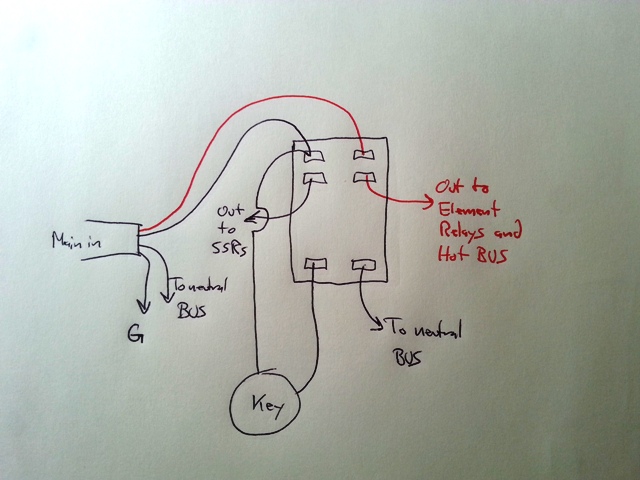I powered up my control panel for the first time today and was greeted with a very loud buzzing from the relay that handles main power on/off. We're talking loud like I had to put in earplugs to troubleshoot.
My panel is a 2 element, 30A system. I used Kal's system as a basis for my wiring plan. Both legs of the power line connect in to the relay, one leg runs out directly to the element relays and the other leg to the SSRs. I use a key switch to turn it on and off. A quick sketch is attached.
The whole panel is getting power (PIDs, pumps, etc). The element relays are the same type and when I turn them on, I get the same buzzing. Also, I can see that my element on light flickers a bit.
Seems to me (from my zero electrical experience) that the noise is coming from the contacts inside the relay opening and closing really fast, but I have no idea why this could be.
Here is a link to the relays I am using. I did go cheap, so perhaps I am paying for that...
Any advice is appreciated!
http://www.zoro.com/magnecraft-enclosed-power-relay-30a-120vac-dpst-92s7a22d-120a/i/G2290127/

My panel is a 2 element, 30A system. I used Kal's system as a basis for my wiring plan. Both legs of the power line connect in to the relay, one leg runs out directly to the element relays and the other leg to the SSRs. I use a key switch to turn it on and off. A quick sketch is attached.
The whole panel is getting power (PIDs, pumps, etc). The element relays are the same type and when I turn them on, I get the same buzzing. Also, I can see that my element on light flickers a bit.
Seems to me (from my zero electrical experience) that the noise is coming from the contacts inside the relay opening and closing really fast, but I have no idea why this could be.
Here is a link to the relays I am using. I did go cheap, so perhaps I am paying for that...
Any advice is appreciated!
http://www.zoro.com/magnecraft-enclosed-power-relay-30a-120vac-dpst-92s7a22d-120a/i/G2290127/




